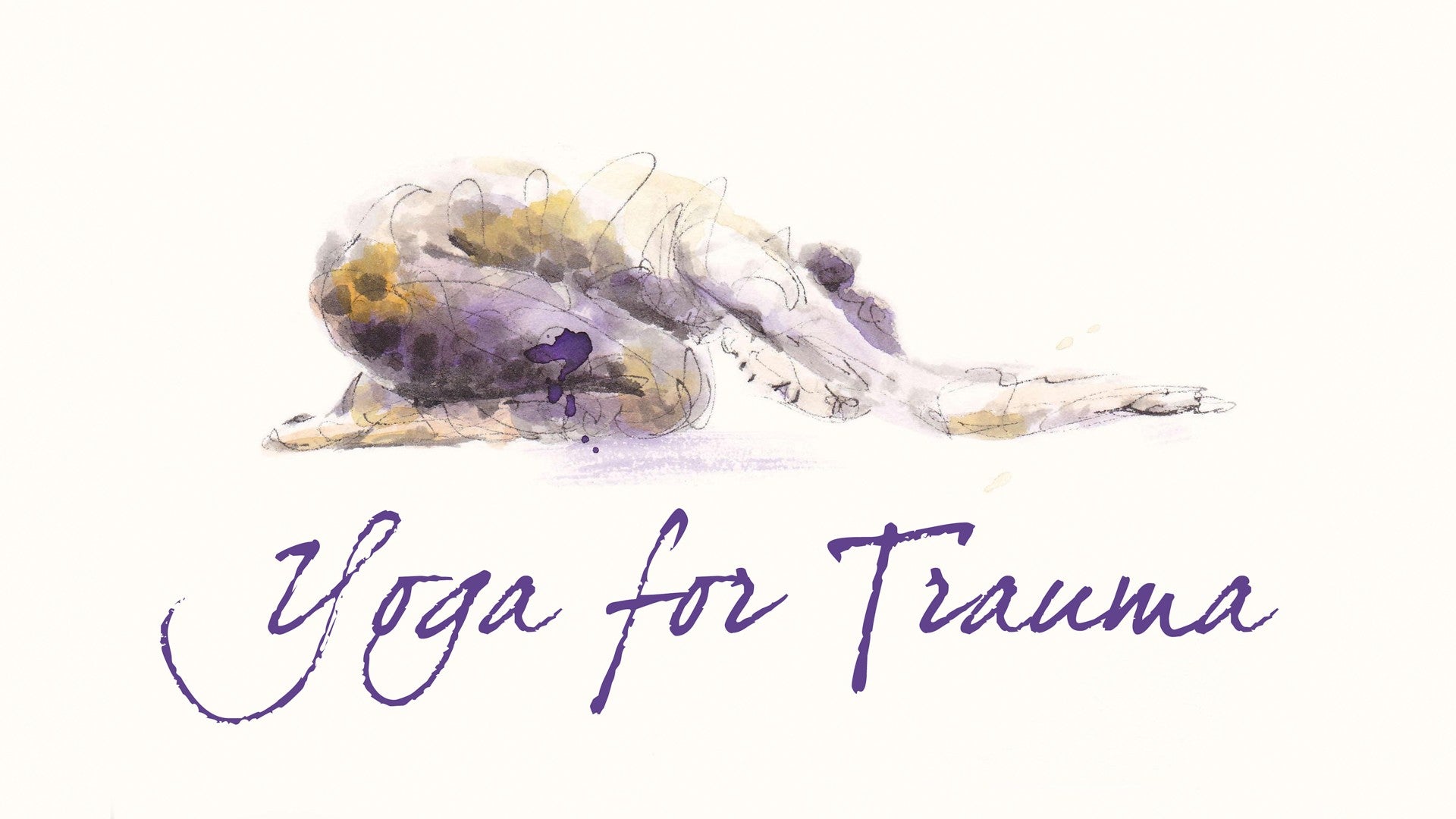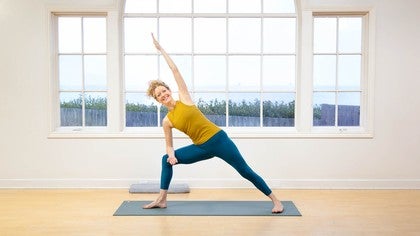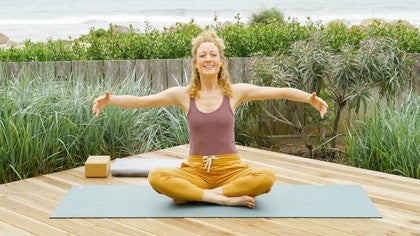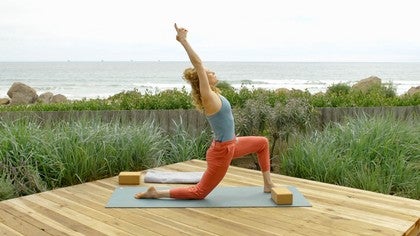Description
About This Video
Transcript
Read Full Transcript
Hi there, and welcome to today's practice. Today's practice is really around reminding ourselves of our capacity. When we're dealing with a lot of overwhelm or trauma, it's going to be hard to access that capacity, our ability to focus, to set boundaries, to show up in our lives. Sometimes it just feels like there's too much, and we don't have enough room, and other times it's like, where does the energy even live? But it's in there, I promise.
So hopefully the practice will remind you of that. And I want to remind you that you have the agency to show up to this practice exactly as you need. So if you don't have a lot of reserves today, maybe your choice today, or your way of setting boundaries is to move a little bit slower, or to take a rest pose or restorative pose for half of the practice, or the full practice. And for others of you, maybe it's about honing into present moment experience, and one aspect of the movement, or a position in the body, or the space that you're in in the moment. So wherever you are, remember this is your practice, no one else's, and you always, always have the right to take pauses, to chill, to jump in a little bit stronger as you need.
So with that, let's get started. We're actually going to begin by just noticing where we're beginning from, like if you were just to take a moment, either hands down or in connection somewhere in yourself, just scan from the top of your head down through your feet. Check out what's happening in the physical body. Pockets of tension, pockets of ease. Notice the energy body in general, is it really high tone, is there lots of stress, is it really low tone, is it some place in between?
Notice the mind. And with all of that information, I'm going to suggest that we begin by actually doing a little bit of a shakeout. The shakeout can disrupt some of the patterns that our nervous system, our brain, our stories create. So if there's a lot of overwhelm and moving feels almost like impossible at the moment, I want you to do it slow, just gentle, it might even be imperceptible from the outside world. When I work with folks in my clinical practice as a therapist and I see them go into a freeze response, I remind them to do their gentle shakeout is this, just moving the shoulders.
Now if you've got a lot of pent-up energy or you're just ready to kind of tap in today, you might make it a bit more vigorous. Both are fine, both are needed at different points. We all have different nervous systems moving through different aspects of the world and we want to make it all alright. So we're going to do this for about another 15 seconds or so. Some of you might want to amplify it.
Wherever you are, imagine that this energy can just go down, down, down, down. So there's also a sense of connecting to earth. Number five, four, you might even stick out the tongue, three, two, through the belly, the heart, and one, and then slow it down. Yeah, notice the tingling, the pulsing, the current, right? There's life in you, there's capacity there.
Let's step to the short edge of the mat. We'll take the feet about hip distance, if you'd like to take it wider, do it, spread the toes, okay? And as we sit down for the chair pose, notice that I'm moving my shins towards the wall behind me so more weight is in my heels instead of my knees. On the in-breath, consider lifting your arms up. We're going to do that again.
Just bending down into it, arms will swim back almost like a superhero cape and then inhale up. Now in this next one, we're going to stay, right? So stay in the legs, but swim with the arms, that's it. We'll do that one more time. And as this is happening, as we're pulsing with the arms and staying in this chair pose, how can you increase your capacity to maybe be here or to show up?
We're going to stay with the arms wide open like a V or like cactuses for three, maybe that means touching into the breath. Sensing the heels or releasing the jaw and one and go ahead and press to standing. Sense all of the tissues and muscles that help you be upright. We're going to rise up to the balls of the toes, reach the arms and see if you can touch the opposite shoulder and then lower down. Now as you do this, rising up to the balls of the toes, switch the arms, this is always confusing for me, try to touch the opposite shoulder without jutting the head too far forward and back down, right?
Take a moment to just soften the soles of the feet. Notice how you can be both upright and steady ease with ease. We'll lift the arms up moving more now into the surinamaskar. As you're ready forward fold, consider unlocking your knees as much as you need. This might also be a place where you are using blocks today.
We're going to lengthen inhale to halfway position and then step back to a downward facing dog. Now options for this, right, might be on your knees instead. You might be moving through cat and cows instead of through a chaturanga or a plank. On your next inhale though we'll move to plank. Feel the backs of the ears lift towards the ceiling.
On the exhale lower all the way down to the earth. Notice how your arms can hug into your ribs anchoring the legs, the tops of the feet into the earth, lifting the space of the low body and core muscles and remember your core goes all around through your back. Lengthen up into your cobra and back down again, pressing earth away. This is a choice point. Do you go to child's?
Do you go to downward dog? Take two breaths wherever you land. How would it be to connect to support? To recognize where the breath is moving in your body at this moment. At the bottom of the next exhale bend the knees or come on up and walk, hop, float to the front of your mat.
Inhale we're going to lengthen. Exhale bow. Maybe you're lifting the backs of the legs a little bit more towards the ceiling. Bring the sitting bones down, rise all the way up, sweeping through space and bring yourself back to you, home base. One more time there is a releasing into the earth, there's a steadiness through some part of the body and there's a reach.
Bowing. Consider lengthening the breath as you look up. Keep reaching the heart forward, step back, maybe float back this time and we'll lower down either to the earth or chaturanga or some of you are moving in cat and cows. Upward or cobra. Lifting from the base of the pelvis through the navel, through the crown and back.
On your in breath shift forward one more time to the top of the pushup and remember this can be done on the knees. And then back either to child or dog. Now we're moving steady, smoothing out the jagged parts of movement and breath. Just here. On your next in breath shift to the plank pose and hold.
We'll be here for two cycles of breath. Notice how maybe collecting in through your midline, you notice something about you. You can reach back through your heels and through the crown of the head, you might also be able to release your jaw. Alright, when you're ready place the knees down, lower all the way to the earth. We're actually going to roll over onto our back now.
So come on to the back. Then pause. Here's another choice point. This might be a place where you pause and you breathe into your middle. This also might be a place where we start to engage more into the core muscles.
Now when I talk about the core muscles I am not talking about chiseling into any specific shape that is determined by dominant culture that's often very violent for most of us leaving us feeling inadequate. Not about that. It's about really connecting into the power, to the capacity of support for the spine, for the digestive track, for the sense of self within. So let your sitting bones get heavy. Think about the weight of those lower pelvic, the lower bones in the pelvis.
And now draw the space of the low belly down into the earth. Usually when I do that my pelvis or my tailbone kind of rounds up. So I have to think like, oh yeah, heavy. Allow those floating ribs to not get small but just to maybe move towards the back body so your back can have more real estate. Oh my goodness, back body awareness.
Hands come to the base of the skull. On the exhale we're going to lift up drawing the lower belly down. Keep dropping the sitting bones. And then inhale to release. Two more times.
Exhale heaviness in the sitting bones, tailbone. Inhale up. Now if you're like me, you're feeling a little bit of quaking already. That's okay. Shaking can sometimes be a sign of transformation.
Let's hold right here. Notice what you're trying, how you're trying to move through this. Are you trying to move through it from your head and your face or from the inner part of your body? Try drawing the awareness in the stability to the inner part of the body as you float your knees up. Now my sitting bones are still heavy and I'm imagining I'm holding something between my thighs so the inner leg muscles are awake.
Tap down. One toe taps and then the other. And we'll go two more times, keeping the elbows broad. Trying to stay stable, just tilting the legs. Last one, side to side.
And then bring the knees into the chest, release the head. Let the head move a little side to side. Tongue releases. Check out the energy now. If it was low, has the energy come up?
If it was high, has it come down a little bit? What would allow it to move into more of a tolerable window of energy for you? Movement, we're going to come up again, bringing the shins parallel to the earth. You might also, if you're dealing with back issues, have the feet on the ground, always an option. Lower ribs soften, exhale to lift.
Now this time, twist towards your right knee, extend left, keep both ribs lifted. All right, come back to center. Bring the lower center core muscles down, center. As you twist around the midline of you, what runs through the right and left hemispheres of you, you might imagine, here I am, I'm centered. I'm connecting.
One more. Now if you'd like to do more, go ahead, be my guest. Otherwise hug the knees in, keep the head lifted. We're going to exhale, extend both legs, both arms. I'm lifting my feet up a little higher towards the ceiling to protect my back.
Exhale in. You can adjust that level for you. Arms open so I can see them in my periphery, and then draw it in. One more time. Breathing out beyond the toes and the fingers, and there's a middle of you, and squeeze.
You might even appreciate the body lower down. Let the neck, the throat, the jaw release. Take an open mouth audible exhale to rumble some of that vagal pathway to remind it that this activation, this arousal that's happening in the system isn't dangerous. It's okay. Uh-huh, and then coming on up, let's move into a staff pose.
As you move into the staff pose, again, the knees might be down, tops of the feet pressing, forearms pressing, and think about the whole back body that you can't see. That might be invisible to you, but it actually exists. You might try to feel with your mind's eye how the back body can lift up towards the ceiling. Three, two, one, lower down. We're going to turn your forearm parallel with the front of the mat, and just move over to the side.
Now, I'm going to take my top foot and put it in front of my bottom leg, and then press the hip up. Here's one option. On the knife edge of my extended leg foot, you might also have the feet together. Shoulders on the back pressing down and rebounding up. Lower the hips down, press it away.
If this bothers the shoulder at all, come off, back the neck long, and up. Great. I'm going to lower down. So now we're going to go to the other side, and when I turn away, especially if you're watching visually with the screen or with the practice, just notice what happens to your body when you can't see my face during this practice. Might be totally fine.
There might be some other response, and just notice that. I'm still here, okay? So go over to the other side, and again, you might take the top foot and bring it in front for some extra stability. Let the shoulder blade be on the back, and then go ahead and press up. You need to use the inner thighs as well as the side body.
And remember, our core isn't just the rectus abdominis, like that six-pack area muscle or whatever that is. It wraps all around from the back to the front. So we're going to lower a little bit and lift. Keep pressing through the feet, and noticing this back body can stay open and long. Hold it for just a moment as you breathe, right?
And then go ahead and come on back to the center. You might find plank. You might find a rest. Hi, it's good to see you again, for real. Take your right hand down, your left hand down, downward-facing dog.
And as you're ready, walk, step, jump, handstand, fly, levitate, I don't care. Down to the front, halfway, and bow. Rise up, all the way up, and hands down. And just take a beat to see what's happening inside now. Notice your alertness to the environment or to yourself.
Nothing else that's present in your system right now. We're going to actually open up to the wide edge of the mat. Let's take a wide Warrior II pose, Virabhadrasana II. Generally heel to heel or heel to arch. It's one way to do it.
Knee mostly in line with your second and third toes over your ankle. We just don't want it beyond the ankle a lot, so there's too much pressure in the knee. Okay, again, props are optional. I'm going to reach the front arm out and bring the forearm to the thigh. Some of you, another option, might drop the bottom hand down towards the floor or behind.
Consider taking the top arm alongside of the ear, looking straight forward or up. And then looking down with the out breath. One more time. Breathing out the inhale, steadying on the exhale. Smooth out the inhale, bring the arm either directly out of the shoulder or alongside of the ear.
Steady your gaze. Quiet the fingers and the face. Easy breath. Beautiful. The top arm is going to swim down now and find a runner's lunge.
Reach the heart forward. I'm going to scoot my back foot in a little bit for stability. So again, checking of where do I find stability as you come upright. Bring the hands onto the hips. I'm bending my front knee and I'm going to lean forward because in a moment we're going to lift off towards a little balance.
Okay, so today the capacity might be with the back foot on the ground. Today the capacity might be all the way up. Imagine you could fly. What helps you fly? Consider air breath.
And now we're going to bring the back knee through. Bend into your standing leg and cross the left knee over the right. Hug towards your middle. Maybe eagle arms or hug arms. I'm just going to do a hug arm today, but feel free to take your eagle.
Steady the gaze. Make sure there's space in the base of the skull, somewhere in your midsection. And then as you're ready, we'll lift back up. Step back. Turn to the long end of the mat.
Other side. Right toes out, right toes in, Virabhadrasana II. Again, just check this stance for yourself. When I think of capacity, sometimes I think of like my arms can be really wide open and I can hold a lot. Other times my capacity is here.
You are allowed to express both in this practice. Go to where you notice your capacity. I'm going to extend the front arm, hinging at the hips, forearm to the thigh. Take your variation, top arm alongside of the ear, looking down as the back arm lowers. One more time.
And down. Top arm might reach up or alongside of the ear. Steady the gaze at one point. See if you can sense whatever is holding you inside, outside in your life. Consider adding some breath with it.
And then let the top arm come down, runner's lunge. Adjust the stance so you can feel steady enough to stand up and maybe today in order to stand up, you use some furniture, you use the wall. That's all okay. You fall over a little bit. Hands are going to be on the hips and I'm going to look ahead with focus at one point.
Sensing the support from the core that we got into, sensing the inner thigh muscles and then lifting off in both directions, back forward. Maybe the back leg lifts, maybe it doesn't. How do we stay curious to where our capacity is right now? On the next in breath, let's bring that back knee forward, cross it over the bottom, sitting down into the cherished thing. Hug the outer edges of the body in towards you and find your position, whether it's eagle arms, it's a hug and see maybe what it's like to shift your gaze slightly, possibly a millimeter up or down.
What brightens your heart rate, what dampens it a little bit, the more you can be aware as we lift the front knee up, extend it back, the more you have the capacity to modulate your response, your boundaries, your approaches. Let's walk the feet in a little bit closer. I'm going to come down into a squat. I'm going to use a blanket today. So if your heels are not touching down when you find the squat, you might bring a blanket under the heels for that feedback and support.
You might also come onto your back for a happy baby pose. That's what that is. And some of us, the uprightness, the agency is like a good reminder of like, yeah, I got this. And others of us, especially if we're holding a lot, it might be a, I'm going to set it down for a minute. Wherever you are, could your teeth in your throat soften three to 5% okay?
Not your teeth, your jaw, just your jaw. Okay. Let the breath come in and out beautiful. So let's start to come out of this. We're going to move into a seated position, continue to use your props as you need.
We'll bring the soles of the feet together, spread the toes and allow the thighs to draw down towards earth. You might sense that oppositional energy of drawing down, letting the shoulders and the arms have some effort while there's some ease through the middle. You might choose to move forward a little bit if there's a lot of tightness in the hips. Bringing the hands back. And remember, tightness in the hips is not an indication of worthiness, nor is it necessarily an indication of trauma for goodness sakes, it just might be tightness in the hips.
So add some just kindness and compassion to whatever is happening in the body at this moment. Some appreciation and dignity for however your body shows up. And then coming on up, we'll extend the legs out. Not the widest you can actually move your legs in the range of motion, but just enough where there's an opening. And see if you can find just a moment of symmetry or the idea of symmetry.
If moving forward is interesting to you, come on forward. Wherever you are now as we come more in towards stillness, remember that there is a flow and a current, a rhythm that's within. Take one more cycle of breath here. Once you're ready, looking up, walk the hands back in. And I'm going to suggest for you to set yourself up into a comfortable position, just laying down into a rest, and if laying down doesn't make sense for whatever reason, consider coming into a seated position, maybe moving yourself against a wall.
Any place where you can get a little bit of feedback, of support. And I'm actually going to come up so I can guide you, but feel free to stay in whatever sort of rest you have found. From the top of the head all the way down through the feet, wherever it is, notice whatever connection you are in. Hold not only from the earth rising up to support you, but also the air around. Consider releasing the tongue in your mouth, the jaw, allowing the ears to open, soften.
The eyes to sink back in their sockets. All the way down through the throat, through the chest, the torso, both arms, both legs. Letting the back body release and the inner body release any tension that isn't needed at this moment. It's resting into you, recharging this capacity, because yes, you have it, and it does need to be recharged, it does need to be supported, 100%. And you are worthy of that time.
Whatever humanness deserves that time. So consider staying in this space for a little longer, 5 minutes, 15 minutes, an hour if you need, and yielding to this recharging of capacity and the awareness that it's already within. I'll see you in the next practice. Thank you so much for being here.
Yoga for Trauma
Comments
You need to be a subscriber to post a comment.
Please Log In or Create an Account to start your free trial.
















